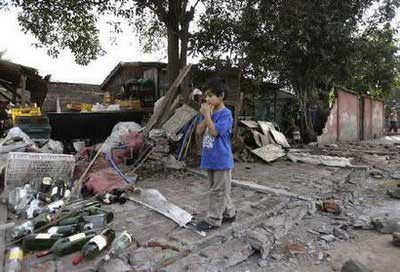|
 A boy stands amid the rubble of his home after a major earthquake in Santiago February 27, 2010. Chile has called of next week's double bill of friendlies against Costa Rica and North Korea after the massive earthquake which hit the country.(Agencies)
|
|
The huge earthquake that struck off the coast of Chile belongs to an "elite class" of mega earthquakes, experts said, and is similar to the 2004 Indian Ocean temblor that triggered deadly tsunami waves. The magnitude-8.8 quake was a type called a "megathrust," considered the most powerful earthquake on the planet. Megathrusts occur when one tectonic plate dives beneath another. Saturday's tremor unleashed about 50 gigatons of energy and broke about 340 miles of the fault zone, according to the US Geological Survey's National Earthquake Information Center. The quake's epicenter was offshore and occurred about 140 miles north of the largest earthquake ever recorded — a magnitude-9.5 that killed about 1,600 people in Chile and scores of others in the Pacific in 1960. "It's part of an elite class of giant earthquakes," said USGS geologist Brian Atwater. If the magnitude holds, it will tie with the 1906 offshore Ecuador quake as the fifth largest since 1900. "We call them great earthquakes. Everybody else calls them horrible," said USGS geophysicist Ken Hudnut. "There's only a few in this league." The Chile quake was smaller than the Sumatra quake of 2004, a magnitude-9.1 and was not expected to be anything nearly as destructive. That quake and ensuing tsunami killed 230,000 people. Another difference is that the Chile quake triggered tsunami warnings hours ahead of time in Hawaii and Pacific islands, allowing people time to flee to higher ground. In 2004, there was little measuring technology in place to warn Indian Ocean countries about incoming killer waves. More than 100 aftershocks measuring magnitude-5 or larger rattled Chile throughout the day. So far, the quake death toll has surpassed 300 — a number that will likely rise. Several more died when tsunami waves swamped an island off the country's coast. Chile is no stranger to violent jolts. In fact, USGS geophysicist Ross Stein called the country an "earthquake hatchery." Thirteen temblors of magnitude 7 or larger have hit Chile since 1973. (Read by Renee Haines. Renee Haines is a multimedia journalist at the China Daily Web site.) |
智利附近海域日前遭遇特大地震,據專家介紹,此次地震屬于超級大地震中的“頂尖級別”,與2004年那場引發致命海嘯的印度洋地震不相上下。 智利發生的這場里氏8.8級大地震屬于“大逆沖型地震”,只有當一個地殼板塊俯沖至另一板塊的下方時才會發生,被認為是地球上威力最強的地震。據美國地質調查局國家地震信息中心統計,上周六發生于智利的地震釋放了大約500億噸能量,而且造成約340英里長的斷層帶破裂。 此次地震的震中位于海上,位于史上規模最大的、發生于1960年的智利9.5級地震的震中以北140英里處。這場地震造成約1600人遇難,并造成太平洋海域的很多人喪生。 美國地質調查局的地質學家布萊恩?阿特沃特說:“這場地震屬于超級大地震中的頂尖等級。” 如果按照震級來劃分,這次地震將與1906年發生于厄瓜多爾附近海域的地震并列為1900年以來的第五大地震。 美國地質調查局的地球物理學家肯?赫德納特說:“我們稱它們為超級地震,它們的力量十分可怕。這種級別的地震不是很多。” 與2004年蘇門答臘島發生的里氏9.1級地震相比,此次智利地震的規模相對較小,據估計其破壞性也相去甚遠。2004年的蘇門答臘島地震及其引發的海嘯導致23萬人喪生。另一個區別在于,提前數小時發布的海嘯預警讓夏威夷和太平洋島嶼的居民有了充分的逃命時間。 而2004年,由于勘測技術有限,無法向印度洋國家發出大規模海嘯襲擊的預警。 當天,智利還發生了100多次里氏5級或更大級別的余震。截至目前,地震死亡人數已超過300,而這一數字還有可能會繼續上升。地震引發的海嘯還席卷了智利附近海域的一個島嶼,造成數人死亡。 智利是個大地震多發的國家。美國地質調查局地球物理學家羅斯?斯坦稱其為“地震孵化器”。自1973年以來,智利共發生了13次里氏7級或更高級別的地震。 相關閱讀 (中國日報網英語點津 Julie 編輯蔡姍姍) |
|
Vocabulary: temblor:earthquake(地震) tectonic plate:地層,地殼板塊 fault zone:斷層 swamp:to flood or drench with water or the like(淹沒,覆沒) |
